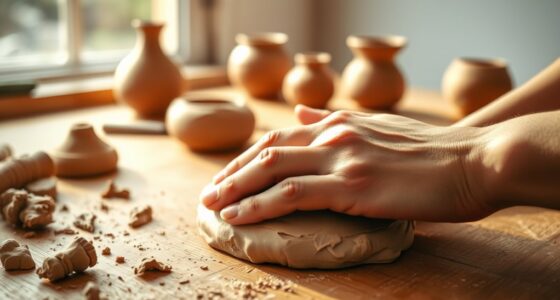To start basket weaving, focus on creating a sturdy rim by bending and securing your materials into a circular edge. Then, build a solid base by weaving within the rim, choosing simple or intricate patterns based on your skill level. Your weavers—thinner strips—are interlaced through the rim and base to shape the basket’s sides. Mastering these elements guarantees strength and style. Keep exploring how each part connects for more weaving success.
Key Takeaways
- The rim forms the basket’s edge, providing structural support and shaping the overall form.
- The base sets the basket’s size and stability, built after establishing the rim.
- Weavers are interlaced materials that create the basket’s walls, added through various weaving techniques.
- Proper preparation of natural materials enhances flexibility and ease of weaving.
- Consistent tension and technique ensure the basket’s shape, strength, and structural integrity.

Have you ever wondered how simple materials like reeds and willow can be transformed into functional, decorative baskets? The answer lies in understanding the basics of basket weaving, particularly how to work with natural materials and the weaving techniques involved. These materials are readily available and versatile, making them ideal for both beginner and experienced weavers. When you start a basket, you’ll notice that selecting the right natural materials is essential. Reeds, willow, rattan, and bamboo are popular choices because they’re flexible yet sturdy enough to hold shape. Each material has its unique qualities, but they all share the characteristic of being natural, renewable resources that can be shaped with the right techniques.
As you explore basket weaving, focus on mastering various weaving techniques. These techniques involve interlacing your weavers through the foundational elements like the rims and bases. Initially, you’ll create a sturdy rim, which serves as the basket’s edge and provides structure. To do this, you bend and secure the natural materials into a circle, often reinforcing it with additional wraps or bindings. Once the rim is in place, you’ll construct the base, which is usually a flat or slightly rounded platform. The base sets the size of your basket and determines how many weavers you’ll need. You can start with a simple weaving pattern, such as over-under, which is fundamental in basketry, or move on to more complex techniques like twining or plaiting as you gain confidence.
The core of your basket is built by adding weavers—long, flexible pieces that you interlace through the base and around the rim. With each pass, you tighten or loosen the weave to achieve the desired shape and stability. Natural materials lend themselves well to these weaving techniques because they can be bent, split, or soaked to increase pliability. As you work, pay attention to tension; consistent tension guarantees your basket maintains its shape and strength. Over time, you’ll develop a rhythm, and your understanding of how different weaving techniques impact the structure becomes clearer.
Frequently Asked Questions
What Are the Best Materials for Basket Weaving?
You should choose natural fibers like rattan, willow, or reed for traditional basket weaving, as they are durable and easy to work with. If you’re looking for something more weather-resistant or budget-friendly, synthetic options like plastic or resin can work well. Both types of materials offer unique benefits, so pick based on your project’s purpose and environment, ensuring your basket is sturdy and long-lasting.
How Do I Choose the Right Size for My Basket?
To choose the right size for your basket, imagine the purpose it’ll serve. Will you hold small trinkets or larger items? Selecting correct measurements is essential—measure the items you want to store or carry, then add a little extra for comfort and flexibility. Think about where you’ll place the basket and how much space you have. This way, you’ll craft a perfect fit that meets all your needs.
Can Basket Weaving Be Done With Synthetic Materials?
Yes, you can definitely weave baskets with synthetic materials. Synthetic fibers are popular because they’re durable and resistant to moisture and pests, making your basket last longer. When choosing materials, look for high-quality synthetic fibers that mimic natural textures. You’ll find they’re easy to work with, flexible, and perfect for creating sturdy, long-lasting baskets that can handle everyday use without breaking down.
What Safety Precautions Should I Take During Weaving?
You should always wear safety gear like gloves to protect your hands from splinters or cuts, and goggles to shield your eyes from flying debris. Set up a clean, well-lit workspace with plenty of space to move freely, keeping tools organized and within reach. Avoid distractions and take regular breaks to prevent fatigue. By following these precautions, you’ll weave safely and enjoyably, no matter what materials you’re working with.
How Do I Repair a Broken or Damaged Basket?
Think of your basket as a story needing a few stitches to continue its tale. To repair a broken or damaged basket, you start with basket repair by carefully aligning the broken parts. Then, use similar material for restoration, weaving new fibers into the old to blend seamlessly. Secure loose ends, reinforce weak spots, and gently restore its strength. With patience and precision, you’ll bring your basket back to life, ready to serve again.
Conclusion
Now that you know the basics of rims, bases, and weavers, you’re ready to start creating your own baskets. Remember, patience and practice are key—like Sarah, who started with a simple basket and now crafts intricate designs. Every weave teaches you something new, so don’t get discouraged by mistakes. Keep experimenting, and soon you’ll turn your skills into beautiful, functional pieces that reflect your unique style. Your basket weaving journey has just begun!








